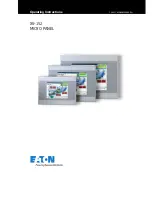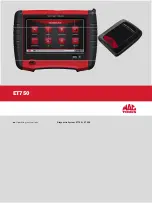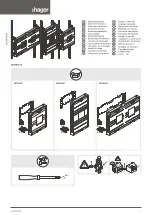
WCB11070 (PDF FORMAT)
11
©
Copyright Eaton Corp. 2007, All Rights reserved.
3.2
Pressure and Speed Limits
3.2.1
Maximum applied air pressure is 150 PSIG (10.2 bar).
3.2.2
Maximum coolant pressure allowable within the water
cavities is 40psi(2,7 bar) for size 36 and 48 WCB2
units and 45psi (3,1 bar) for all other sizes. The use of
an accumulator or pressure relief valve may be desir-
able to reduce the effect of pressure spikes in the
coolant system during operation.
Maximum allowable water pressure is depen-
dent upon tensioner size. Water piping eleva-
tions, restrictions in outlet piping or pressure
surges may cause pressures that exceed the
maximum allowable, resulting in damage to
the tensioner.
3.2.3
Maximum slip speeds and free wheeling disc speeds
are shown in Table 9.
Excessive slip speeds will result in rapid fric-
tion material wear. For good life of wear com-
ponents, the operating values in Table 9
should not be exceeded.
3.3
Periodic Maintenance
3.3.1
As the friction material wears, adjustment of the ten-
sioner may be required to keep pistons within the
proper stroke range. See Section 4.0 for wear mea-
surement, adjustment procedures and component
wear limits
.
3.3.2
Periodically check for external air leakage in the area
of the piston seals (21) (23). For replacement, refer to
procedures in Section 4.0, Maintenance.
3.3.3
Moisture that may accumulate in the cylinder can be
purged. With air pressure exhausted from the cylinder,
remove the pipe plug (105) at the 6 o'clock position on
the cylinder, and apply low air pressure to assist in
expelling any excess moisture. After draining the cyl-
inder, reinstall the pipe plug, applying a pipe thread
sealant on the threads prior to installation.
Applied air pressure greater than 10psi
should not be used when draining the cylin-
der. Use adequate shielding to avoid contact
with direct spray from moisture being purged
from the cylinder.
3.3.4
Periodically observe the rotating discs while the ten-
sioner is fully released. Dragging discs may be
caused by wear or contamination of the gear or disc
splines, lack of spline lubrication, disc imbalance,
warped discs, or misalignment. Correct as required.
3.3.5
Pneumatic and electrical control interlocks should be
periodically checked for proper settings and operation.
3.3.6
If leakage or blockage of any watercooled chamber is
suspected, a static or dynamic test may be performed
as follows:
TABLE 8
Maximum Outlet
Coolant Temperature
Water/Ethylene
Glycol Mixture % by
Volume
Maximum Outlet Coolant
Temperature°F (°C)
100/0
150 (66)
70/30
165 (74)
60/40
165 (74)
50/50
170 (77)
TABLE 9
Maximum Disc Speeds
Size
Max. Slip Speed
RPM
Max. Free
Wheeling
Speed RPM
8WCB2
2150
3400
14WCB2
1260
2100
18WCB2
955
1600
24WCB2
715
1200
36WCB2
475
700
48WCB2
360
600















































